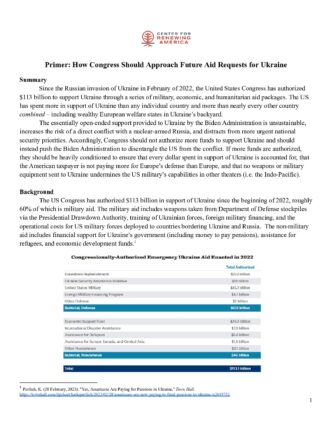
Primer: How Congress Should Approach Future Aid Requests for Ukraine

Summary
Since the Russian invasion of Ukraine in February of 2022, the United States Congress has authorized $113 billion to support Ukraine through a series of military, economic, and humanitarian aid packages. The US has spent more in support of Ukraine than any individual country and more than nearly every other country combined – including wealthy European welfare states in Ukraine’s backyard.
The essentially open-ended support provided to Ukraine by the Biden Administration is unsustainable, increases the risk of a direct conflict with a nuclear-armed Russia, and distracts from more urgent national security priorities. Accordingly, Congress should not authorize more funds to support Ukraine and should instead push the Biden Administration to disentangle the US from the conflict. If more funds are authorized, they should be heavily conditioned to ensure that every dollar spent in support of Ukraine is accounted for, that the American taxpayer is not paying more for Europe’s defense than Europe, and that no weapons or military equipment sent to Ukraine undermines the US military’s capabilities in other theaters (i.e. the Indo-Pacific).
Background
The US Congress has authorized $113 billion in support of Ukraine since the beginning of 2022, roughly 60% of which is military aid. The military aid includes weapons taken from Department of Defense stockpiles via the Presidential Drawdown Authority, training of Ukrainian forces, foreign military financing, and the operational costs for US military forces deployed to countries bordering Ukraine and Russia. The non-military aid includes financial support for Ukraine’s government (including money to pay pensions), assistance for refugees, and economic development funds.

Source: Committee for a Responsible Federal Budget
According to the Kiel Institute for the World Economy, in the first year of the war, the US provided Ukraine directly with $71 billion worth of aid (in the form of both cash and military hardware), the majority of which was military aid, while European Union institutions and member nations provided roughly half that at $35 billion, the majority of which was non-military aid.
US military aid to Ukraine has severely depleted American arsenals. The already-strained US defense industrial base cannot sustain current levels of Ukrainian munition expenditures, much less replenish American stockpiles. For example, the US has sent approximately 8,500 Javelin anti-tank missiles to the Ukrainian Armed Forces. At current production rates, it would take up to 8 years to replenish our stockpiles, assuming no more missiles are sent to Ukraine. Similarly, the US has provided over 1,600 Stinger missiles to Ukraine. The US has not produced any Stinger missiles since 2003, but under maximum estimated restored production rates, it would take at least six years to replenish our stockpile. Additionally, the US has sent Ukraine over a million artillery shells. The US produces around 20,000 artillery shells a month, with plans to increase its production to between 70,000 to 90,000 shells a month over the next several years. However, Ukraine’s Defense Minister Oleksiy Reznikov has said that his forces may need up to 500,000 shells a month to sustain a counter-offensive – far outpacing current American and European production rates.

Even factoring in projected increases in production, the US mathematically cannot maintain its current level of munitions supply to Ukraine and replenish its stockpiles at a rate sufficient to support the US military in another major conflict.
Many of the weapon systems that the US is supplying to Ukraine are also needed by Taiwan to deter or defeat a Chinese invasion. Currently, there is an approximately $19 billion backlog of weapons deliveries to Taiwan, partly caused by the US prioritizing arms supplies for Ukraine. Many of the same weapon systems being supplied to Ukraine (Harpoon missiles, HIMARS rockets, etc.) are also needed by Taiwan and other East Asian partners, creating real trade-offs against the US’s ability to deter Chinese aggression.
There is also a real risk that weapons sent to Ukraine could fall into the wrong hands. Ukraine historically has been one of the most corrupt countries in the world and has a history of being a source of illicit arms smuggling – including for advanced weapon systems. For example, Ukraine has provided cruise missile technology to Iran, sold China its first aircraft carrier, and also likely provided rocket engines that enabled North Korea to launch its first intercontinental ballistic missile.
Finally, the provision of funding, weapons, or training of certain military units by the US which enable the Ukrainian military or intelligence services to conduct attacks inside Russia substantially raises the risk of escalation between the US and Russia. Recently, a Russian exile neo-Nazi group called the Russian Volunteer Corps conducted several raids within Russia with American-made armored vehicles supplied to them by the Ukrainian government. This incident is also a clear example of American military supplied to Ukraine falling into the hands of extremist organizations, despite promises from the Biden Administration that aid to Ukraine was being properly tracked and accounted for.
Policy Recommendations
The United States Congress should authorize no further aid to Ukraine. With nearly ten times the GDP of Russia and a strong industrial base, the US’s European allies have more than enough military and financial capacity to sustain Ukraine. As a result, they should take the lead in not only supporting Ukraine but also securing Europe as a whole. Likewise, the Biden Administration should disentangle the United States from its current level of involvement in the conflict. Any future engagement should be primarily focused on driving a diplomatic settlement to the war.
Additionally, Congress should avoid granting Ukraine NATO membership or any permanent American security guarantees. NATO membership for Ukraine could cost the US up to $27 billion in upfront costs and $13 billion annually, according to an analysis by the Center for International and Strategic Studies (CSIS). NATO membership for Ukraine also means extending the US’s security umbrella to Ukraine, which would risk sending America’s sons and daughters to fight in the current conflict or a future war with a nuclear-armed Russia.
If Congress does authorize further aid to Ukraine, it must be conditioned in the following ways:
- Conduct a full audit of existing aid programs and appoint a Special Inspector General for Ukraine Aid. Considering the history of endemic corruption and illicit arms trafficking in Ukraine, every dollar of aid and every weapon must be properly accounted for before any more is provided to Ukraine. The recent announcement that an “accounting error” led the Pentagon to overestimate the cost of weapons supplied to Ukraine by over $6 billion further reinforces the need for a full audit along with the appoint of a Special Inspector General to oversee existing aid programs before any additional taxpayer dollars are sent to Kyiv.
- Ensure that total US aid to Ukraine does not exceed the level provided by the European Union (EU). The war in Ukraine is largely a European security challenge, yet the amount of aid provided by the US is almost twice that provided by the EU. Wealthy countries like Germany have not pulled their weight in regard to supporting Ukraine and have continued to free-ride off the American security umbrella provided through NATO. Accordingly, the amount of US aid to Ukraine should not exceed that provided by the European Union.
- Prevent the supply of weapons to Ukraine that would degrade the capabilities of the US military in more critical theaters – specifically the Pacific. The US’s supply of critical munitions is dangerously low, largely due to the Biden Administration’s Ukraine aid programs and the decrepit state of our defense industrial base. Going forward, the United States should not supply any weapon systems or munitions that would degrade the ability of the US military to engage in sustained combat operations in key theaters like Indo-Pacom.
Conclusion
The United States has no vital national interests at stake in Ukraine. The amount of aid spent supporting Ukraine is far out of alignment with its importance to American safety and economic prosperity. Worse, the Biden Administration’s Ukraine policy has distracted the United States from more important national security priorities while raising the risk of a direct conflict with a nuclear-armed Russia.
The Constitution vests Congress with significant powers in regard to shaping American foreign policy. It is absolutely critical that the United States Congress use that power to course-correct America’s Ukraine strategy. Our current policy of supplying massive amounts of weapons to Ukraine while continually increasing tensions with Russia is increasingly unsustainable and risks a wider conflict. Failure to choose a different path in regard to Ukraine could lead to a national security catastrophe that imperils the safety of the American people.




